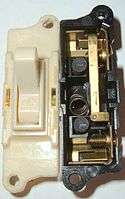Electrical contacts

An electrical contact is an electrical circuit component found in electrical switches, relays and circuit breakers.[1] Each contact is a piece of electrically conductive metal. When a pair of contacts touch, they can pass an electrical current; when the pair is separated by an insulating gap, then the pair does not pass a current. When the contacts touch, the switch is "closed"; when the contacts are separated, the switch is "open". The gap must be an insulating medium such as air, vacuum, oil, SF6 or other electrically insulating fluid. Contacts may be operated by humans in pushbuttons and switches, by mechanical pressure in sensors or machine cams, and electromechanically in relays. Contact materials are usually composed of superior conduction materials such as silver or gold.[2][3] Cheaper metals may be used to reduce costs for the main contact bump and plated with superior metals.
Even when contacts are separated, there may be a conductive path due to arcing or a glow discharge.
Contact states

A normally closed (N.C.) contact pair is closed (in a conductive state) when it, or the device operating it, is in a de-energized state or relaxed state.
A normally open (N.O.) contact pair is open (in a non-conductive state) when it, or the device operating it, is in a de-energized.
An example of a normally open contact usage is the common door-bell push button.
Latching state devices
Where the state of the operating device can be latched in either state and therefore the normal state is not clearly defined a different style of contact definitions may be used.
Form A contacts
A Form A contacts ("make contacts") are normally open contacts.[2] The contacts are open when the energizing force (magnet or relay solenoid) is NOT present. When the energizing force is present, the contact will close.
Form B contacts
A Form B contacts ("break contacts") are normally closed contacts.[2] Its operation is logically inverted from Form A.
Form C contacts

A Form C contacts ("change over" or "transfer" contacts) are composed of a normally closed contact pair and a normally open contact pair that are operated by the same device; there is a common electrical connection between a contact of each pair that results in only three connection terminals. These terminals are usually labelled as normally open, common, and normally closed (NO-C-NC).
These contacts are quite frequently found in electrical switches and relays as the common contact element provides a mechanically economical method of providing a higher contact count.
KYZ contacts used on energy meter outputs are an example of Form C contacts where each contact reversal or contact state change represents a measured amount of energy (Kp, Ki or Ke).
Early make, late break

The order in which make and break occurs in a group of contacts is usually non-overlapping. Break comes before make. But with an early make and a late break contact the order is overlapping.
Contact wipe
Contact wipe is an action designed into a contact so that the contact motion exceeds the initial electrical contact touch point. Using a flexible contact arm causes the contact surface to wipe against its counterpart as the arm bends slightly. This removes oxide and contaminants from the electrical contact surface, counteracting electrical resistance build-up.
Bifurcated contact
A bifurcated contact is a contact whereby each contact arm splits into two smaller arms each with its own contact bump. Only one electrical circuit can be used for this arrangement. This is a design feature to help ensure more stable mechanical operation, improve electrical contact and heat dissipation.
Electrical ratings
Contacts are rated for the current carrying capacity while closed and the voltage breaking capacity when opening (due to arcing) or while open. Opening voltage rating may be an A.C. voltage rating, D.C. voltage rating or both.[4] Some manufacturers offer guaranteed minimum operation counts based on accelerated testing.
Arc snuffing
In high current and high voltage applications a secondary contact may be used to transfer load to a load break mechanism in order to avoid arcing wear and tear of the main contact.
Many other methods to avoid arcing of contacts are used including air blasts, magnetic forces, elongation of arc, alternate resistive current paths and various combinations of these methods.
Materials Used
Cold headed contacts can be produced from a wide variety of materials. Typical alloys include:[5]
- Silver
- Fine grained silver
- Silver-Nickel
- Silver-Iron
- Silver-Graphite
- Silver-Cadmium Oxide
- Silver-Tin Oxide
- Gold
- Platinum
- Palladium
- Paliney® alloys[6]
See also
References
- ↑ http://www.galco.com/comp/prod/relay.htm
- 1 2 3 Matsushita Electronics, "Relay Techninal Information: Definition of Relay Terminology", § Contact, http://media.digikey.com/pdf/other%20related%20documents/panasonic%20other%20doc/small%20signal%20relay%20techincal%20info.pdf
- ↑ http://www3.panasonic.biz/ac/e_download/control/relay/common/catalog/mech_eng_term.pdf
- ↑ "Potter Brumfield kuep-11d15-24". Retrieved 22 November 2012.
- ↑ http://www.deringerney.com/products-and-capabilities/electrical-contact-manufacturing/contact-rivets/
- ↑ http://www.deringerney.com/products-and-capabilities/electrical-contact-manufacturing/contact-rivets/